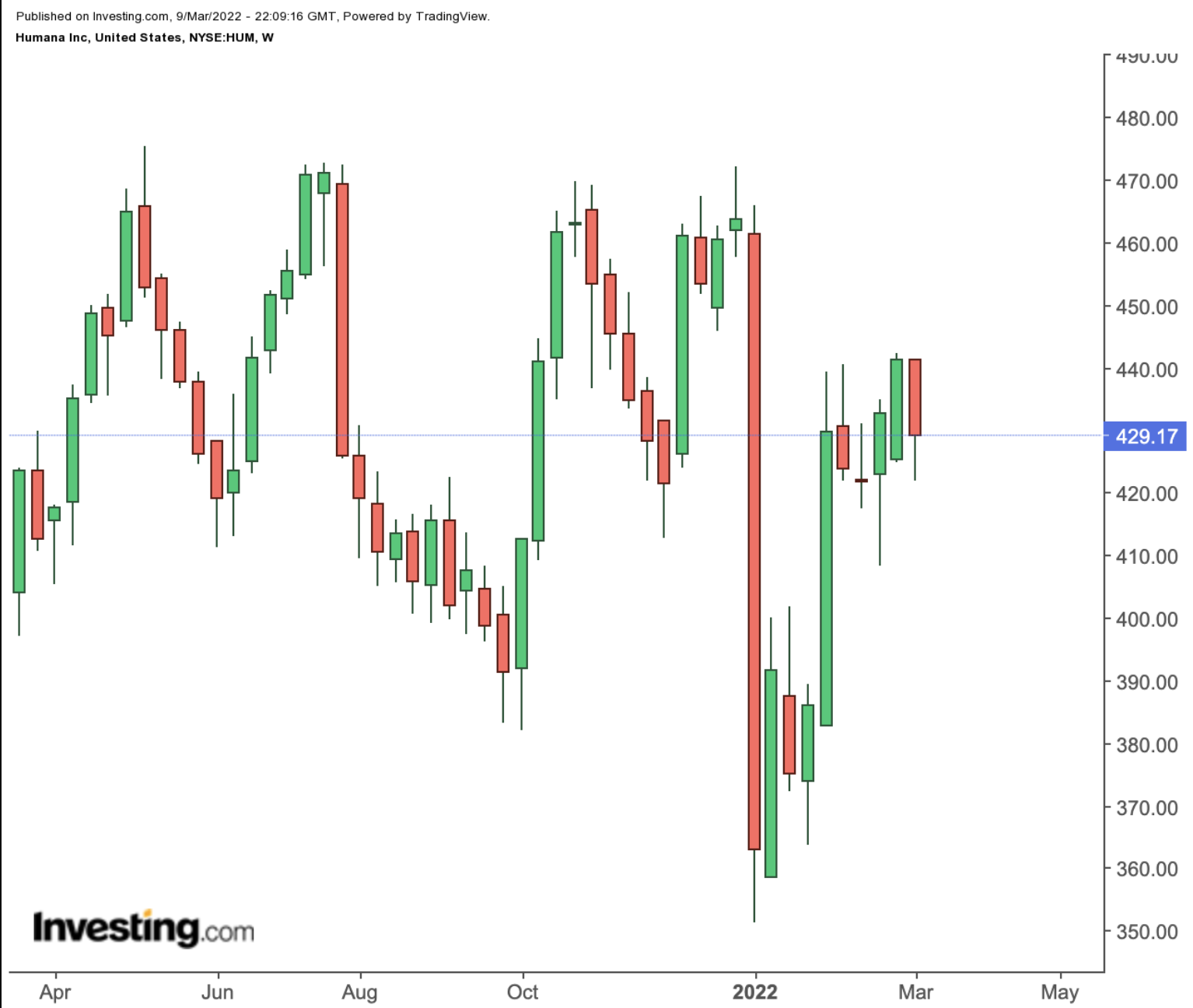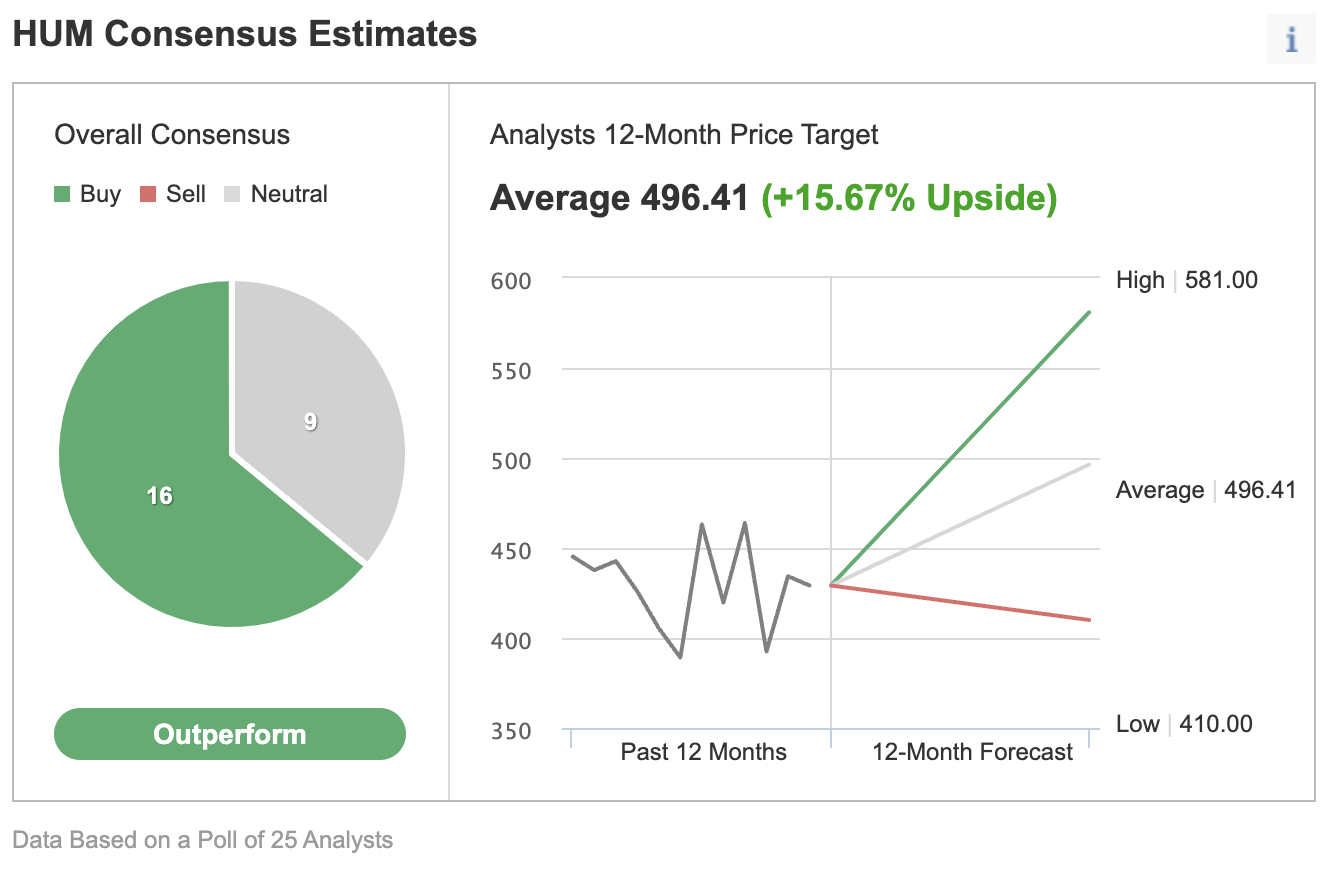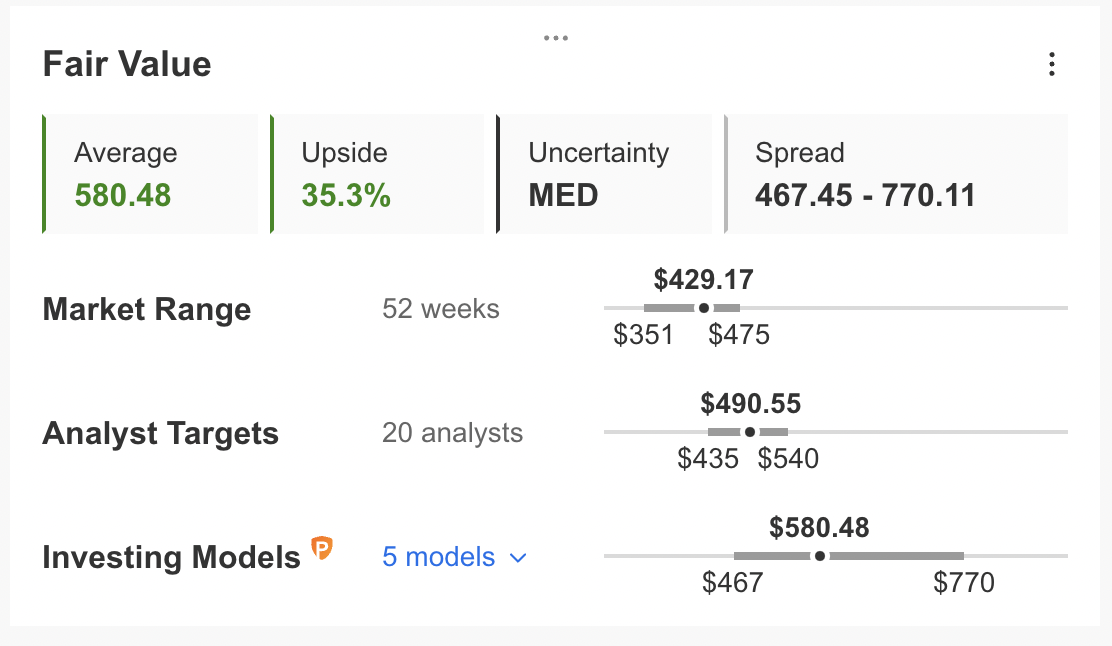- Health insurer Humana's shares are down 7.3% since January
- HUM has been investing in its Medicare Advantage business.
- Long-term investors could consider buying a dip, especially if it declines toward $420
So far in 2022, investors in health insurance heavyweight, Humana (NYSE:HUM), have not had much to celebrate. The stock has lost close to 7.3% since the start of the year. However, shares are still up 6.4% in the past 12 months.

By comparison, the Dow Jones Health Care Providers Index returned close to 22% in the past 52 weeks, but is down 4.1% since January. Meanwhile, Humana’s competitors, Anthem (NYSE:ANTM) and Centene (NYSE:CNC) are both down 0.4% so far this year, Cigna (NYSE:CI) is up 1.2%, Molina Healthcare (NYSE:MOH) is down 2.2%, and UnitedHealth (NYSE:UNH) is down 4.6%.
In May 2021, HUM shares topped $475 to hit a record high. However, since then, they have come under pressure and declined about 9.5%. The stock’s 52-week range has been $351.20-$475.44, while the company’s market capitalization stands at $54.5 billion.
Among the five leading health insurers in the US, Humana, which has been increasing its focus on its Medicare Advantage program, stands in fourth spot, with a 7% market share. The leading names on that list include UnitedHealth (12%), Anthem (11%), and Centene (10%).
Humana released Q4 financials and FY 2021 metrics on Feb. 2. Revenue was $21.2 billion, up from $18.9 billion a year ago. The insurer reported adjusted EPS of $1.24 in the fourth quarter of last year vs. a $2.30 loss per share a year ago. Management now expects to achieve adjusted EPS of $24 in FY22, compared with $20.64 in FY21.
On the results, CEO Bruce D. Broussard said:
"We continue to create value by growing our top-tier Medicare Advantage business, increasing the contribution of our Healthcare Services lines, improving the overall productivity of the organization…"
Prior to the release of Q4 results, HUM stock was changing hands around $400. Now, it is at $430.90. The current price supports a dividend yield of 0.72%.
What To Expect From Humana Stock
Among 25 analysts polled via Investing.com, HUM stock has an "outperform" rating. Wall Street also has a 12-month median price target of $496.41 for the stock, implying an increase of more than 16% from current levels. The 12-month price range currently stands between $410 and $581.

Source: Investing.com
Similarly, according to a number of valuation models, the average fair value for Humana stock on InvestingPro stands at $580.48.

Source: InvestingPro
Fundamental valuation suggests shares should roughly go up by 35%.
At present, HUM’s P/E, P/B and P/S ratios are 18.5x, 3.4x and 0.6x. Comparable metrics for peers in the health-care sector stand at 8.3x, 1.5x, and 0.9x.
Our expectation is for Humana stock to trade in a wide range between $415 and $435 to build a base in the coming weeks. Afterwards, HUM shares could potentially start a new leg up.
Adding HUM Stock To Portfolios
Humana bulls, who believe the decline in the stock is likely to come to an end, could consider investing now. Their target price would be $496.41, or analysts’ forecast.
Alternatively, investors could consider buying an exchange-traded fund (ETF) that has HUM stock as a holding. Examples include:
- iShares U.S. Healthcare Providers ETF (NYSE:IHF)
- American Customer Satisfaction ETF (NYSE:ACSI)
- First Trust Rising Dividend Achievers ETF (NASDAQ:RDVY)
- John Hancock Multifactor Health Care ETF (NYSE:JHMH)
Although investors might want to buy HUM stock for their long-term portfolios, they could also be nervous about further volatility in the coming weeks. Therefore, some might prefer to put together a "poor man’s covered call" on the stock instead.
So, today, we introduce a diagonal debit spread on Humana by using LEAPS options, where both the profit potential and the risk are limited.
Investors who are new to the strategy might want to revisit our previous posts on LEAPS options before reading further.
Most option strategies are not suitable for all retail investors. Therefore, the following discussion on HUM stock is offered for educational purposes and not as an actual strategy to be followed by the average retail investor.
Diagonal Debit Spread On HUM Stock
Price at time of writing: $430.90
A trader first buys a long-term call with a lower strike price. At the same time, the trader sells a short-term call with a higher strike price, creating a long diagonal spread.
Thus, the call options for the underlying stock have different strikes and different expiration dates. The trader goes long one option and shorts the other to make a diagonal spread.
Most traders entering such a strategy would be mildly bullish on the underlying security. Instead of buying 100 shares of HUM, the trader would purchase a deep in the money LEAPS call option, where that LEAPS call acts as a "surrogate" for owning the stock.
For the first leg of this strategy, the trader might buy a deep in the money (ITM) LEAPS call, like the HUM Jan. 19, 2024, 350-strike call option. This option is currently offered at $123. It would cost the trader $12,300 to own this call option, which expires in less than two years, instead of $43,090 to buy the 100 shares outright.
The delta of this option is close to 80. Delta shows the amount an option’s price is expected to move based on a $1 change in the underlying security.
If HUM stock goes up $1 to $431.90, the current option price of $123 would be expected to increase by approximately 80 cents, based on a delta of 80. However, the actual change might be slightly more or less depending on several other factors that are beyond the scope of this article.
For the second leg of this strategy, the trader sells a slightly out of the money (OTM) short-term call, like the HUM April 14 440-strike call option. This option’s current premium is $12.40. The option seller would receive $1,240, excluding trading commissions.
There are two expiration dates in the strategy, making it quite difficult to give an exact formula for a break-even point. Different brokers might offer "profit-and-loss calculators" for such a trade setup.
Maximum Profit Potential
The maximum potential is realized if the stock price is equal to the strike price of the short call on its expiration date. So, the trader wants the HUM stock price to remain as close to the strike price of the short option (i.e., $440) as possible at expiration (on April 14), without going above it.
Here, the maximum return, in theory, would be about $1,826 at a price of $440 at expiry, excluding trading commissions and costs. (We arrived at this value using an options profit-and-loss calculator.) Without the use of such a calculator, we could also arrive at an approximate dollar value. Let’s take a look:
The option seller (i.e., the trader) received $1,240 for the sold option. Meanwhile, the underlying Humana stock increased from $430.90 to $440, a difference of $9.10 per share, or $910 for 100 shares.
Because the delta of the long LEAPS option is taken as 80, the value of the long option will, in theory, increase by $910 X 0.8 = $728.
However, in practice, it might be more or less than this value. There is, for example, the element of time decay that would decrease the price of the long option. Meanwhile, changes in volatility could increase or decrease the option price as well.
The total of $1,240 and $728 comes to $1,968. Although it is not the same as $1,826, we can regard it as an acceptable approximate value.
Understandably, if the strike price of our long option had been different (i.e., not $350), its delta would have been different, too. Then, we would need to use that delta value to arrive at the approximate final profit or loss value.
Here, by not investing $43,090 initially in 100 shares of Humana, the trader’s potential return is leveraged.
Ideally, the trader hopes the short HUM call will expire out of the money, or worthless. Then, the trader can sell one call after the other, until the long Humana LEAPS call expires in close to two years.
